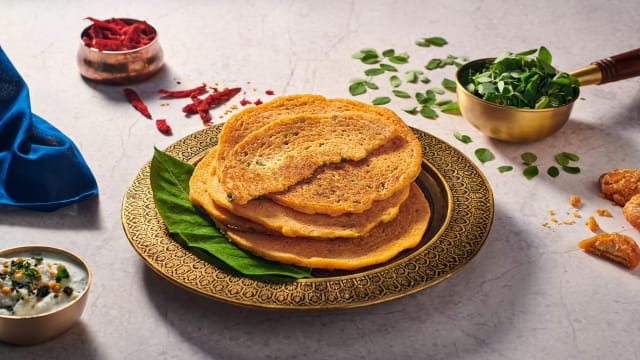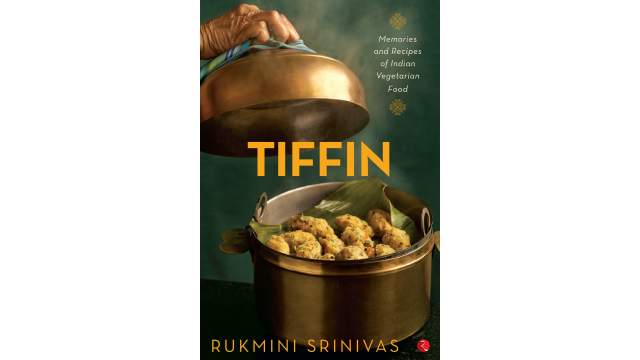
Upma Pesarattu

Upma Pesarattu
Description
Upma Pesarattu is a South Indian dish combining crispy mung dal (green gram) dosa (Pesarattu) with savory semolina upma filling. Sprouted mung dal is a good source of plant-based protein, fiber, and B, C, and K vitamins. The nuts, seeds, herbs, and spices in upma give this energy-boosting dish greater nutritional complexity and a helping of healthy fats.
NOTE
For a lighter meal or quick prep, skip the upma and serve pesarattu with chutney.
Ingredients
8 dosas MAKES
For the Pesarattu
- 1¼ cup (240 g) mung bean sprouts (whole green gram), soaked for 4 hours
- ¼ cup (50 g) idli rice, soaked for 4 hours
- 1 (30 g) small onion, finely chopped
- ½ tsp fenugreek seeds, soaked for 4 hours
- 1-inch-long ginger, grated
- 2 green chiles
- 2 tsp cumin seeds
- 100 ml water for blending
- Salt for seasoning
- 1 tsp cold pressed sesame oil or ghee for each pesarattu
For the Upma
- 1 Tbsp (14 g) ghee
- 5 cashews
- ½ tsp black mustard seeds
- ½ tsp urad dal (skinned, split black lentils)
- ½ tsp chana dal (split Bengal gram)
- 1-inch-long ginger, grated
- 5 to 8 curry leaves
- 1 (30 g) small onion, finely chopped
- 1 green chile, finely chopped
- ½ cup (125 g) fine rava (fine semolina)
- ½ Tbsp salt
- 1½ cup (375ml) hot water
Directions
-
Step 1
To make pesarattu batter: Drain the mung dal and the rice. Add to a blender or food processor along with the onion, fenugreek, ginger, green chiles, and cumin. Add water, a little at a time, to make a thick, gritty batter. Season with salt (about 5 gm) and set aside. -
Step 2
To make the upma: Heat ½ Tbsp of ghee in a kadhai, wok, round-bottomed pot, or other shallow vessel. Cook the cashews to a light golden brown, remove with a slotted spoon and drain on a kitchen towel. -
Step 3
In the leftover ghee, add mustard seeds, urad dal, and chana dal. When the mustard seeds begin to splutter, add the ginger, curry leaves, onion, and chile and cook for about 2 minutes or until the onions are translucent. -
Step 4
Add the rava and cook, stirring continuously, for about 4 minutes or until the rava is fragrant and a light golden brown. Add the cashews and salt. Mix well. -
Step 5
Pour in the hot water, stirring vigorously to prevent lumps until the rava soaks up all the water. Cover and let simmer on low heat for 5 minutes, until the mixture begins to separate from the sides of the pot. Add the remaining ghee, stir, and turn off the heat. -
Step 6
To make the pesarattu: Heat the cast iron pan or dosa kal. Once hot, add about half a cup of the batter and — using the back of a round ladle or a big spoon — spread the batter in concentric circles with swift circular wrist movements to make an 8-inch round. Drizzle oil around the edges and in the center and cook the pesarattu for 4 to 5 minutes or until the bottom is a nice golden brown. -
Step 7
Flip the pesarattu and cook for 2 minutes. Drizzle oil around the edges and cook until the bottom is a warm golden-brown color. Place a spoonful of upma on one side of the pesarattu and flip over the other side to make a semi-circular pocket. Take it off the pan to serve. -
Step 8
Sprinkle water on the pan to bring down the heat, wipe the surface quickly with a clean cloth or kitchen towel, and swipe with a few more drops of oil. Repeat to make more dosas — you should get about 8 total. Serve hot with allam pachadi (ginger chutney). Store any leftover batter in the fridge in an airtight container for up to 3 days. Bring the batter to room temperature before using.
Explore Recipe Ingredients
About the author
More by Rakesh Raghunathan

Kanchipuram Idli
Rakesh Raghunathan recreates a heritage recipe, offered as a sacred temple food, that is healing and supports gut health.

Milagapodi
Rakesh Raghunathan’s milagapodi, a nutrient-dense spice blend, is a great condiment for dosas.

Moringa Adai
Fresh moringa leaves amp up the antioxidant quotient of this lentil-based cousin of the dosa in Rakesh Raghunathan’s recipe.



